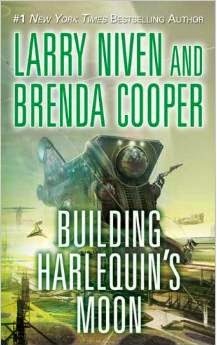Utopia always goes wrong; the best laid plans, etc. is truth as well as a cliché. Sometimes it can take generations for the plans to go awry.
In Building Harlequin's Moon, a novel by Larry Niven and Brenda Cooper, the plan to build utopia goes off the rails right away for the John Glenn, a colony ship fleeing a Solar System filled with rogue AIs. They were supposed to come out at the planet Ymir side-by-side with another colony ship, ready to deploy nanotechnology to terraform Ymir into an ideal place to build a new Earth. Instead, their engines go out of kilter, delivering them to Harlequin.
Their only option is to assemble the material from Harlequin's rings into a moon, then wake the frozen colonists and lead them through terraforming the new moon, Selene. It will take generations of effort to re-create the supplies and fuel they need to go on to Ymir—which by this time, may be already terraformed by the crew and colonists from their sister ship.
It will mean centuries, even millennia, of effort. They must take care not to let the AI tools they have grow too intelligent, lest the same thing that happened on Earth occur in the Harlequin system. And there will not be room in the rebuilt ship for all the colonists on Selene when they are done.
How they balance the needs of the ship with the needs of the colony, the growing tension between the Earth-born ruling elite from the original ship's crew (who seem to live forever due to repeated freezings) and the Children of Selene (the short-lived colonists), and the dawning realization that Ymir might not be the last best hope for the human race after all, give this novel a strength that we haven't seen since Ringworld.
I had trouble getting into the novel; there is a confusion of flash-back and dreaming in the opening chapters that takes some deciphering. Once I had these sorted out in my mind, however, the remainder of the story was very engrossing. This is mostly due to strong characters. An Earth-born woman refuses to take take further restorative Sleep, Selene's Children are growing aware of the way they are being short-changed by the ship's crew, and Gabriel, the leader of the Earth-born crew and the teacher of Selene's Children, will have to make a drastic decision about the future of Selene itself.
It is also absorbing because of Niven's strength in describing future technology and cosmic-sized engineering works. We are there for the building of a planetoid from what is essentially space-dust; we come along while the assembled moon cools and is made habitable. This story is even more enjoyable because all the engineering is the work of Man—no aliens lurk in the corners of the narrative. The closest thing to an alien is the deliberately-crippled AI pilot of the John Glenn, Astronaut, a character strongly reminiscent of Heinlein's Mike in The Moon is a Harsh Mistress.
Larry Niven has a genuine talent for finding collaborative writers and nurturing them, to match with his other well-known talent: creating elaborate, but believable, technological cultures. With Brenda Cooper, he has written a worthy shelf-mate to Ringworld.

No comments:
Post a Comment